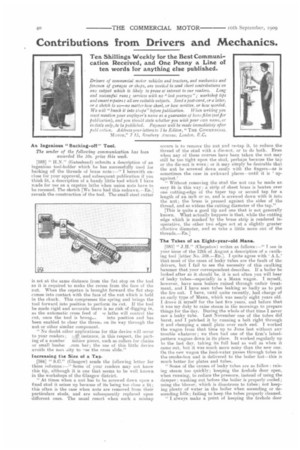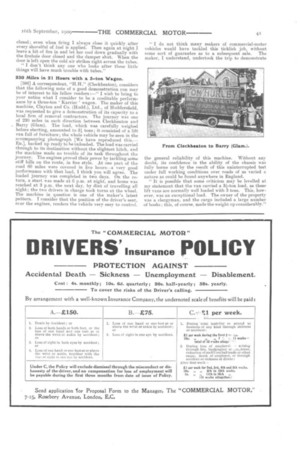Contributions from Drivers and Mechanics.
Page 18

Page 19

If you've noticed an error in this article please click here to report it so we can fix it.
Ten Shillings Weekly for the Best Cornmuni,cation Received, and One Penny a Line of ten words for anything else published.
Drivers of commercial motor vehicles and tractors, and mechanics and foremen of garages or shops, are invitd to send short contributions on any subject which is likely to Prove 01 interest to our readers. Long and successful runs ; services with no "lost journeys"; workshop tips and smart repairs : all are suitable subjects. Send a post-card, OF a letter, or a sketch to us—no matter how short, or how written or how worded. We will "knock it into shape" before publication. When writingyou must mention your employer's name as a guarantee of bona fides (not for publication), and you should state whether you wish your own name, or initials only, to be published. Payment will be made immediately after pthl caticti. Address your letters to 1 he Editor," THE COMMERCIAL.
Moroo," 7 15, Rosebery A vearte. London, E.G.
An Ingenious "Backing-off" Tool.
The sender of the following communication has been awarded the 10s. prize this week.
[583] " H.N." (Gateshead) submits a description of an ingenious tool-holder which he has successfully used for backing off the threads of brass nuts :—" I herewith enclose for your approval, and subsequent publication if you think fit, a description of a handy little tool which I have made for use on a capstan lathe when union nuts have to be recessed. The sketch [We have had this redrawn.—En.] reveals the construction of the tool. The small steel cutter
is set at the same distance from the flat stop on the tool as it is required to make the recess from the face of the nut. When the capstan is brought forward the flat stop comes into contact with the face of the nut which is held in the chuck. This compresses the spring and brings the tool forward into position to perform its cut. If the tool be made rigid and accurate there is no risk of digging in, as the automatic cross feed of te lathe will control the cut, once the tool is lifting.... into position and has been enabled to clear the threat. on its way through the nut or other similar component.
"No doubt other applications for this device will occur
to your readers; ;-#1, instance, in this respect., the part
ing of a number nohow pieces, such as rollers fur chains or small bushe: .rom bar; the use of this little device avoids the neet ,sity to "se the cross slide."
increasing t'ne Size of a Tap.
[584] " S.C." (Glasgow) sends the following letter for these columns ;—" Some of your readers may not know this tip, although it is one that seems to be well known in the workshops of the Glasgow district. " At times when a nut has to he screwed dawn upon a fixed stud it seises up because of its being too close a fit ; this often is the case when nuts are removed from their particulars studs, and are subsequently replaced upon different ones. The usual resort when such a mishap occurs is to remove the nut and re-tap it, to reduce the thread of the stud with a die-nut, or to do both. Even when any of these courses have been taken the nut may still be too tight upon the stud, perhaps because the tap or the die-nut is worn; or it may simply be desirable that the nut be screwed down easily with the fingers—as is sometimes the case in awkward places—until it is upagainst.'
" Without removing the stud the nut can be made an easy fit in this way : a strip of sheet brass is beaten over one cutting-edge of the taper tap or second tap for a length of an inch or so, and is screwed down with it into the nut; the brass is pressed against the sides of the thread, and so widens the cutting diameter of the tap."
[This is quite a good tip and one that is not generally known. What actually happens is that, while the cutting edge which is masked by the brass strip is rendered inoperative, the other two edges act at a slightly greater effective diameter, and so take a little more out. of the threads.—En.]
The Tubes of an Eight-year-old Mans.
[585] " (Chepstow) writes as follows ;—" I see in your issue of the 12th of August a description of a caulking tool letter No. 368.—ED.1. I quite agree with AL.' that most of the cases of leaky tubes are the fault of the drivers, but I fail to see the necessity of this caulking hammer that your correspondent describes. If a boiler be looked after as it should be, it is not often you will hear of leaky tubes—especially in a Mann wagon. I myself, however, have seen boilers ruined through unfair treatment, and I have seen tubes leaking so badly as to put the fire out. I have, until quite recently, had charge of an early type of Mann, which was nearly eight years old. I drove it Myself for the last five years, and before that it was my duty to raise steam in the mornings to prepare things for the day. During the whole of that time I never saw a leaky tube. Last November one of the tubes did burst, and I patched it by running a bolt right through it and clamping a small plate over each end. I worked the wagon from that time up to June last without any trouble whatever; we then had one of the firm's latestpattern wagons down in its place. It worked regularly up to the last day, taking its full load as well as when it came out, hut it was much more noisy than the new one. Ott the new wagon the feed-water passes through tubes in the smoke-box and is delivered to the boiler hot—this is much better for plates and tubes.
" Some of the causes of leaky tubes are as follow : raising, steam too quickly ; keeping the firehole door open, when running, to reduce the pressure, instead of using the damper ; washing out before the boiler is properly cooled; using the blower, which is disastrous to tubes; not keeping plenty of water in the boiler when ascending or descending hills; failing to keep the tubes properly cleaned.
" I always make a point of keeping the firehole door
closed; even when firing I always close it. quickly after every shovelful of fuel is applied. Then again at night I leave a bit of fire in and let her cool down gradually with the firehole door closed and the damper shut. When the door is left open the cold air strikes right across the tubes. " I don't think any one who looks after these little things will have much trouble with tubes."
250 Miles in 21 Hours with a 5-ton wagon.
[586] A correspondent, "II.H." (Cleckheaton), considers that the following note of a good demonstration run may be of interest to his fellow readers:—" I wish to bring to your notice what I consider to be a creditable performance by a three-ton ` Karrier ' wagon. The maker of this machine, Clayton and Co. (Rudd.), Ltd., of Huddersfield, was requested to give a demonstration of its capacity to a local firm of removal contractors. The journey was one of 230 miles in each direction between Cleckheaton and Barry (Glam). The load, which was carefully weighed before starting, amounted to 3?,, tons; it consisted of a lift van full of furniture; the whole vehicle may be seen in the accompanying photograph [We have reproduced this.— ED.], backed up ready to he unloaded. The load was carried through to its destination without the slightest hitch, and the machine made no trouble of its task throughout the journey. The engines proved their power by tackling some stiff hills on the route, in fine style. At one part of the road 60 miles were covered in five hours—a very good performance with that load, I think you will agree. The loaded journey was completed in two days. On the return, a start was made at 6 p.m. at night, and home was reached at 3 p.m. the next day, by dint of travelling all night ; the two drivers in charge took turns at the wheel. The machine in question is one of the maker's latest pattern. I consider that the position of the driver's seat, over the engines, renders the vehicle very easy to control.
I do not think many makers of commercial-motor vehicles would have tackled this ticklish job, without some sort of guarantee as to a subsequent sale. The maker, I understand, undertook the trip to demonstrate the general reliability of this machine. Without any doubt, its confidence in the ability of the chassis was fully borne out by the result of this uninterrupted test under full working conditions over roads of as varied a nature as could be found anywhere in England. " It is possible that some criticism may be levelled at my statement that the van carried a 3i-ton load, as these lift vans are normally well loaded with 3 tons. This, however, was an exceptional load. The owner of the property was a clergyman, and the cargo included a large number of books: this, of course, made the weight up considerably."




















